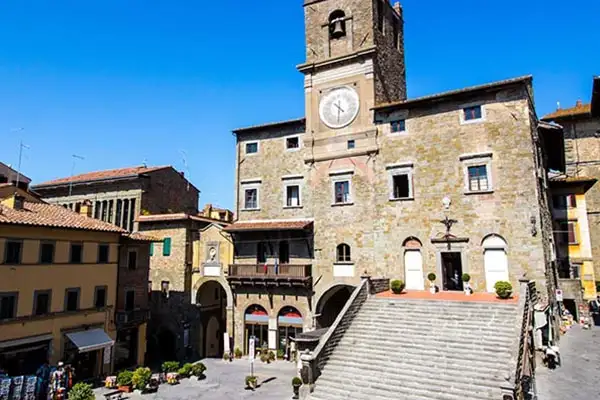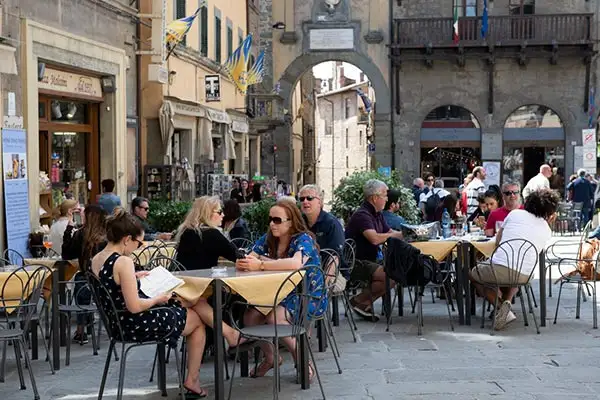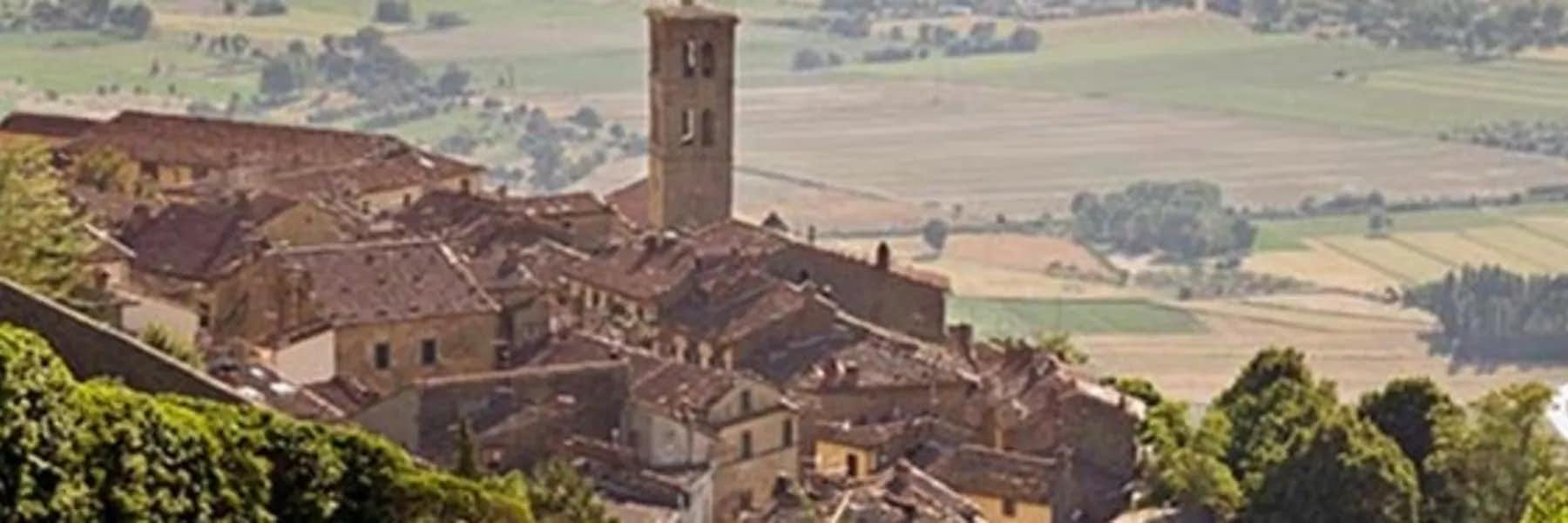It may seem small, but Cortona has never been obscure. A thriving Etruscan city and Roman colony, this small city in southern Tuscany was endowed with marvelous monuments and architecture during the Middle Ages and Renaissance periods. Located just 45 minutes from Arezzo, and near the Umbria border, it’s always held an important place in southern Tuscany’s crossroads.
But it was an American writer who put Cortona firmly on the modern tourism map; this is the town that Frances Mayes immortalized in Under the Tuscan Sun, and subsequent books. Many tourists flock here to walk that ancient Roman road towards Bramasole, to bask in the piazzas, and stroll the streets that Mayes so enticingly described.
Layered on a hill above the Valdichiana (Chiana Valley), Cortona enjoys views over the valley to Lake Trasimeno and oversees the hills of olive groves and wine estates that unfurl below. The setting is quintessential Tuscany, where towering cypress trees line up along country roads winding among stone-built farmhouses.
Retire in Cortona

This city of 23,000 residents is anything but sleepy. It draws more than 200,000 tourists a year, plus folks from surrounding towns who want to enjoy the events, special exhibits, and shows that happen in Cortona throughout the year.
As Cortona grasps onto the hillside, you’ll stay fit if you live amongst the inclined and stair-stepped lanes of the old town center. But the city also has dozens of outlying villages that are part of the town’s territory. Prices in the hamlets are lower than the city and country estates.
Those famous Tuscan landscapes surround you: sunflower fields, olive groves, precise stripes of grapevines. The artisan shops and agricultural traditions carry on here. Whether you dream of a townhouse with everything in easy reach or a stone farmhouse, this place is the stuff of many expat fantasies of what Italian life should be.
It exudes the many millennia of history that has passed by. The sights, artistic displays, and archeology mean you won’t be bored, and you have all of Tuscany and Umbria (and nearby Le Marche) in reach.
The number of tourists may be disconcerting to some, while it’s seen as invigorating to others. Their presence certainly ensures there are plenty of restaurants to enjoy and cafes to sit and enjoy a drink while people watching. Cortona also has a mix of expats from many countries, and the locals are open and accepting.
The weather brings four distinct seasons; expect rain in November and December. Winter averages run from 46 F as a daytime high to 30°F at night. Spring will be in the 60s F but temperatures cool down 20 F or more at night. Summers are hot -expect it to be in the mid-80s F and can reach 90F, but evenings cool down to perfect sleeping temperature in the 60s F. The climate is rather humid overall.
Get Your Free Italy Report Today!
Get Your Free Italy Report Today!
Learn more about Italy and other countries in our daily postcard e-letter. Simply enter your email address below and we’ll send you a FREE report – Italy: Europe’s Most Seductive Country.

By submitting your email address, you will receive a free subscription to IL Postcards and special offers from International Living and our affiliates. You can unsubscribe at any time, and we encourage you to read more about our Privacy Policy.
Lifestyle in Cortona

The setting is idyllic and the town is both rustic and elegant at the same time. It offers all the services and shops you’ll need right there, but hard-core shoppers will enjoy the Valdichiana Outlet Village, just 25 minutes away. Arezzo and Perugia are in reach for their shopping and cultural amenities, too.
Not that Cortona lacks culture. The Signorelli Theater is a lavish space that puts on shows, musicals, and operas. There are musical events, art exhibitions, food festivals, and musical evenings. An annual blow-out is the Giostra dell’Archidado, where the town’s five Quintieri (districts) compete in Medieval regalia and games (remember that flag-throwing scene in the movie, Under the Tuscan Sun?).
Enjoy the stone wall-lined lanes for country walks with panoramic vistas or hikes in the hills to the ruins of abandoned monasteries and castle towers. Hit the course at the Cortona golf club, or bliss out in their spa.
There’s certainly no lack of interesting towns to explore in the area—set out in any direction and spend the day wandering the hills to hidden hamlets and country restaurants.
The closest airport is at Perugia, about 45 minutes away. It’s just over two hours to Florence, and about two-and-a-half hours to Rome and its international airport. Cortona is about equal distance to the Mediterranean and the Adriatic coasts. Nearby Lake Trasimeno offers water fun and ferries to the islands for easier days of sun and splashing.
Cost of Living in Cortona

This is Tuscany, and a well-known town at that, so don’t expect to find bargains here in terms of properties. Current listings run from around $148,000 to $4.1 million (and more!). Rental homes in the city center are hard to find; you’ll need an insider in town to help you find them. Outside the centro storicoand in the surrounding hamlets they more easily available—with furnished apartments running from $531-826. One farmhouse on the outskirts of Cortona has been divided up, and a furnished three-bedroom, two-bathroom home on two floors is renting for $708 a month. It comes with a garden and views.
As a reference, the average home price is $223 per square foot, while rents average $0.74 per square foot. There is a small but bright and fully restored apartment for sale in the centro storico of Cortona, near the main piazzas. It has 535 square feet of well-organized space, wood floors, contemporary bathroom fixtures, and a stone fireplace, $162,830). A larger, 1,496-square foot home in the same district has two bedrooms and two bathrooms, and retains its rustic historic appeal with wood beams and terra cotta floors. It is listed for $218,285.
If it’s a country villa you crave, there’s a stylishly restored, design magazine-worthy villa on offer with quality everything, from the kitchen to baths to the picture-perfect covered dining terrace. It has four bedrooms, three bathrooms, an outdoor kitchen, a swimming pool, and all the luxuries you could want in its 2,648 square feet. It includes a large garden and garage, for $1,026,530.) Want a villa to restore? There’s one of those listed; it’s a regal stone structure with two outbuildings, in need of a complete renovation, priced at $412,972.
The general costs, including grocery prices and utility bills, are in line with everywhere else in Italy. Stop in the fresh pasta shop and buy some just-made ravioli for just $3.70 a pound or tortellini for $4.95 a pound; they have fresh sauces and roasted chickens, along with other prepared dishes for an easy and affordable at-home meal.
Savor the area’s fat strands of picipasta dressed with duck sauce, porcini mushrooms, or wild boar sauce. Or pillowy ricotta-gnocchi, or truffled-studded tagliatelle. You’ll pay between $9 to $13 a plate in one of Cortona’s trattorias. Tuscans like their meat, especially game, so guinea hens, rabbit, duck, and boar are frequent main dishes, along with that massive T-bone steak known as Bistecca alla Fiorentina. The Chianina cattle that it’s made from are raised down in the valley. Meat mains generally run from $11 to $23 a plate. Sit down a piazza café and sip some local wine for $5 to $7 a glass, accompanied by nibbles.














